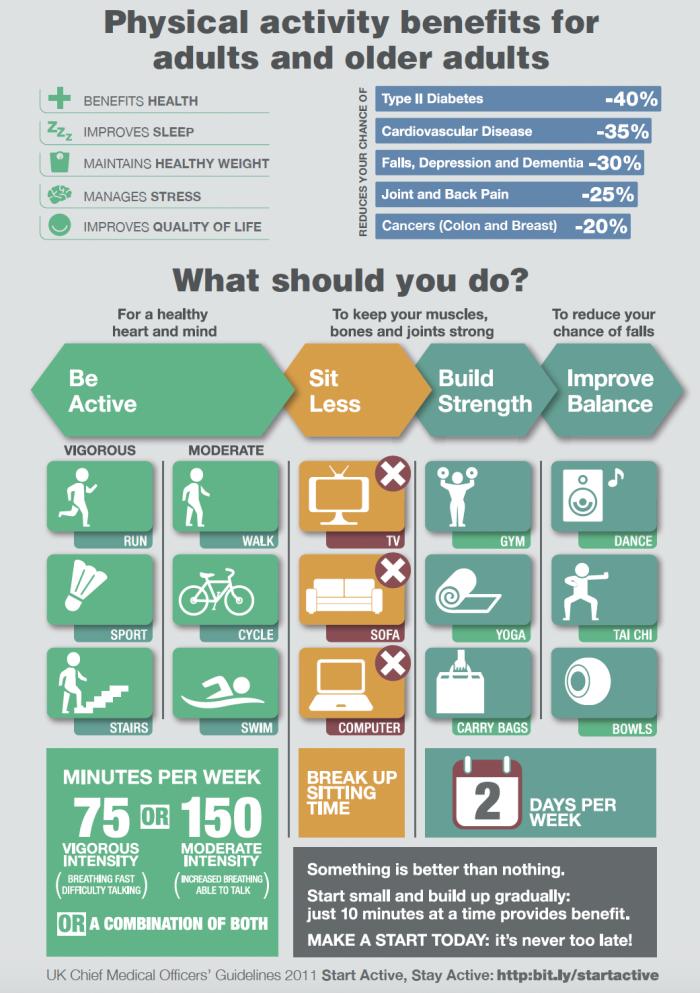Foot and Ankle Osteoarthritis
Dealing with foot and ankle arthritis
Being active can help to manage pain and fatigue caused by arthritis. There is no set approach that has been shown to be the best so feel free to try different types of exercise and activity. Be guided by what you enjoy and what you feel able to start. An example may be cycling, a pilates or aqua-aerobics class.

Keeping active also means trying to continue, where you can, your normal daily activities including social, work-related and hobbies.
If you are local to Sheffield and you would like support to increase your physical activity, then you can:
- Self-refer to Sheffield Physical Activity Referral scheme to access expert and discounted support in physical activity including select gyms across the city.
- Find sport, leisure and activity groups in your local area.
- Visit our page on physical activity under the wider health section of the website for further guidance and support to increase your activity.
Weight management and nutrition. If you are living with overweight or obesity then losing weight and having a healthy diet has been shown to reduce pain and improve the function of the foot/ankle in those with osteoarthritis. There isn’t a specific diet that’s been proven to help with osteoarthritis, however if you need to lose weight, try to follow a balanced, reduced-calorie diet. The Association of UK Dieticians also has an informative leaflet on diet and OA.
See our page on healthy weight under the wider health section of the website for guidance and support with losing weight.
Consider your footwear. Getting the right footwear can improve comfort and help you to stay active. Here our some tips to consider when choosing footwear:
- Wear shoes with a low heel and a wide front. This means that your feet will have enough room and your toes can spread out as you walk.
- Get your shoes professionally fitted if possible, as feet can change size. Try to get shoes with a gap of 1 cm between the end of the shoe and your longest toe.
- Buy shoes in the afternoon, as your feet can swell up during the day. Trying them on in the afternoon will give you a better idea of how they fit.
- Avoid wearing shoes that don’t support your feet, like ballet pumps and flip-flops.
- Wear shoes with thick, cushioned soles to reduce the stress that walking puts on your joints.
- Try to get shoes that are deep and soft on the top, so that they’re comfortable and flexible.
- Shoes with laces or adjustable straps will help keep your foot in place, and stop your toes being pushed to the front of the shoe.
- A light but stiff walking boot can help ankle pain.
Go to our comprehensive Footwear guide to find more about how you can choose the right shoe for you.
Heat or Ice treatment
- Heat packs. You may find that applying heat to the sore area helps relieve your pain and any associated muscular tightness or spasm. Use a microwaveable wheat bag or a hot water bottle wrapped in a towel. Keep it on for 15 – 20 minutes, checking your skin regularly to minimise the risk of suffering burn. Repeat 2-3 times per day. Do not place heat on a swollen body part.
- Ice packs. This can help to temporarily numb pain. Apply an ice pack (or a bag of frozen vegetables wrapped in a tea towel) to the area for up to 10 minutes, 2-3 times per day.
Pain medication. Taking pain medication may control the pain so that you can stay mobile. Speak to your GP or a pharmacist for further advice.
Further Treatment
Podiatrist
Not everyone needs to be seen by a podiatrist, however, some people may find a more tailored treatment programme beneficial. Treatment should primarily include active strategies such as exercise. It can often take at least 3-6 months of consistent rehabilitation before you start to see improvements, so be patient and work with your podiatrist to get the most from your programme.
Steroid injection
In some cases when pain is severe, a steroid injection into the joint may provide short term pain relief. It is worth noting that steroid injections are not a long term management option as they can make the tissue less healthy in the long term.
Surgery.
A very small proportion of people with foot and ankle osteoarthritis may be suitable for surgery, however this type of surgery comes with risks and fortunately most people benefit from conservative treatment. Your health care professional can guide you with this option.
Treatments which are not recommended by National Guidelines:
- Acupuncture or dry needling.
- Electrotherapy treatments such as TENS machines.
- Routine use of insoles, braces, tape, splints or supports.
- Hyaluronic acid injections.
- Glucosamine and chondroitin supplements.
Treatments which may be considered:
- Manual therapy but only alongside exercise, as there is not enough evidence to support its use alone for managing osteoarthritis.
- Walking stick or aid, only if it is likely to improve movement and function.
See NICE guidelines for Osteoarthritis for further information